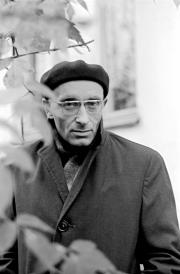
Born into a family of physicians, Oskar Rabin was orphaned at the age of thirteen. In 1942, Rabin met the artist and poet Yevgeny Kropivnitsky and began taking his classes at the art studio at the House of Pioneers, and later found a second family in his teacher’s home. In 1944, he moved to Riga, where he studied from 1946 to 1948 at the Academy of Arts. Then at the Surikov Moscow State Art Institute (1948-1949), from which he was expelled for “formalism.” In 1957, Rabin took part in the show of young artists of the USSR during the Sixth World Festival of Youth and Students in Moscow and received a bonus for participating, which let him get a job Décor and Design Workshop of the Art Fund RSFSR.
Oskar Rabin is a key figure of the “Lianozovo Group,” a circle of poets and artists, friends and relatives of Yevgeny Kropivnitsky. Rabin was one of a few underground artists who consistently and openly tried to fight the system “from inside,” getting permission for exhibitions and defending his independent view of art. In 1960, the newspaper Moskovsky komsomolets ran an article, “Priests of ‘Dump No. 8’,” criticizing his work. In 1965 the Grosvenor Gallery held Rabin’s personal show, which was the first one-man exhibition of a Russian unofficial artist in London.
Rabin continued to seek opportunities to show his work. He participated in the risky project on the Enthusiasts Chausee in Moscow, organized by Alexander Glezer (1967), almost losing his work as a result, and in the Bulldozer Exhibition (1974), which he had initiated with Vitaly Komar and Alexander Melamid. In 1978, Rabin traveled to France with his wife and son, Alexander, where he learned that he had been stripped of his Soviet citizenship and could not return. After Perestroika, the artist was given back his Soviet citizenship and then Russian citizenship. In 2006, Oskar Rabin was awarded the Innovation State Prize “for his contribution to the development of modern art.” He lives in Paris.
Rabin’s artistic manner, which formed in the second half of the 1950s, did not change throughout his creative path. It was based on a plastic language elaborated within the traditions of Russian and German Symbolism and Expressionism of the 1910s-1930s. The themes of Rabin’s paintings were a revelation for their time, dealing with the lower depths of society: barracks, rubbish dumps, unsightly slums. Rabin’s painterly style is characterized by a markedly dark color scheme and black contours. He was among the first to incorporate captions and symbolic signs into his landscapes, a method later taken up by Moscow Conceptualism.